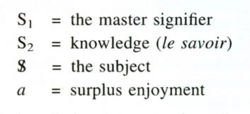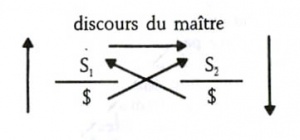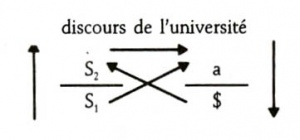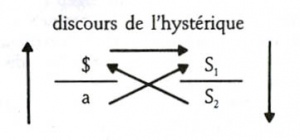Difference between revisions of "Discourse"
| (59 intermediate revisions by 4 users not shown) | |||
| Line 1: | Line 1: | ||
| − | + | {{Top}}[[discours]]{{Bottom}} | |
| − | |||
| − | language, the fact that speech always implies another subject, an | + | =====Discourse of the Other===== |
| + | The term "[[discourse]]" is used by [[Lacan]] to emphasize the ''[[intersubjectivity|transindividual]]'' [[nature]] of '''[[language]]''', the fact that '''[[speech]]''' always implies [[another]] [[subject]], an interlocutor. | ||
| − | + | The '''[[unconscious]]''' is the "[[discourse|discourse of the Other]]", the effect on the [[subject]] of [[speech]] that is addressed to that [[subject]] from elsewhere, by another [[subject]] (who has been [[memory|forgotten]]), by an [[scene|other scene]] or [[scene|psychic locality]]. | |
| − | + | =====Social Bond===== | |
| + | In 1969, [[Lacan]] begins to use the term "[[discourse]]" to denote a "[[discourse|social bond]], founded in [[language]]." | ||
| − | + | He [[identifies]] ''four'' types of [[discourse|social bonds]], four articulations of the [[symbolic order|symbolic network]] which regulates [[intersubjectivity|intersubjective relations]]. | |
| − | + | =====Four Discourses===== | |
| + | These "[[discourse|four discourses]]" are | ||
| − | + | * the [[discourse]] of the '''[[master]]''', | |
| + | * the [[discourse]] of the '''[[university]]''', | ||
| + | * the [[discourse]] of the '''[[hysteric]]''', and | ||
| + | * the [[discourse]] of the '''[[analyst]]'''. | ||
| − | + | =====Four Algorithms===== | |
| + | [[Image:Letdis.jpg|thumb|250px|right|[[Algebra]]ic [[symbol]]s from the [[Four Discourses]]]] | ||
| − | + | Each of the [[discourse|four discourses]] is represented by an [[matheme|algorithm]] which contains ''four'' [[algebraic]] [[symbol]]s. | |
| − | + | The names of these ''four'' [[symbol]]s are shown to the [[right]]. | |
| − | + | The ''four'' [[symbol]]s correspond to ''four'' different [[discourse|positions]] in each [[matheme|algorithm]] of the [[discourse|four discourses]]. | |
| − | + | Each [[matheme|algorithm]] of the [[discourse|four discourses]] has ''four'' different [[discourse|positions]] with which the ''four'' [[symbol]]s correspond. | |
| − | + | [[Image:Discourse-Structure.jpg|thumb|250px|right|The structure of the four discourses]] | |
| − | + | The [[discourse|position]] of the ''four'' [[symbol]]s in each [[matheme|algorithm]] is what distinguishes the [[discourse|four discourses]] from one another. | |
| − | + | The [[discourse|four discourses]] are distinguished from one another by the [[discourse|positions]] of these ''four'' [[symbol]]s in each [[matheme|algorithm]]. | |
| − | + | Each of the [[discourse|four discourses]] is defined by the [[discourse|position]] of the ''four'' [[symbol]]s in its [[matheme|algorithm]]. | |
| − | + | The names of the ''four'' [[discourse|positions]] are shown to the right.<ref>{{S20}} p. 21</ref> | |
| − | + | =====Discourse of the Master===== | |
| + | [[Image:Madis.jpg|thumb|right|[[Discourse]] of the [[Master]]]] | ||
| + | The [[discourse]] of the [[master]] is the basic [[discourse]] from which the other [[three]] [[discourse]]s are derived. | ||
| − | + | The '''dominant [[position]]''' is occupied by the [[master signifier]] ([[Image:SS1.gif]]), which represents the [[subject]] ('''S''') for another [[signifier]] or, more precisely, for all other [[signifiers]] ([[Image:SS2.gif]]); however, in this [[signification|signifying operation]] there is always a [[surplus]], namely, ''[[objet petit a]]''. | |
| − | + | The point is that all attempts at totalization are doomed to failure. | |
| + | The [[discourse]] of the [[master]] "masks the [[division]] of the [[subject]]."<ref>{{S17}} p. 118</ref> | ||
| + | The [[discourse]] also illustrates clearly the [[structure]] of the [[dialectic]] of the [[master]] and the [[master|slave]]. | ||
| − | + | The [[master]] ([[Image:SS1.gif]]) is the [[discourse|agent]] who puts the [[slave]] ([[Image:SS2.gif]]) to [[work]]; the result of this work is a [[surplus]] (''[[objet (petit) a|a]]'') that the [[master]] attempts to appropriate. | |
| − | + | On the gif the right-side S barré is a typo. It must be changed to [[objet]] [[petit a]] (as rightly described. | |
| − | + | =====Discourse of the University===== | |
| + | [[Image:Unidis.jpg|thumb|right|[[Discourse]] of the [[University]]]] | ||
| + | The [[discourse]] of the [[university]] is produced by a quarter turn of the [[discourse]] of the [[master]] (anticlockwise). | ||
| − | + | The dominant position is occupied by [[knowledge]] (''[[savoir]]''). | |
| + | This illustrates the fact that behind all attempts to impart an apparently "neutral" [[knowledge]] to the [[other]] can always be located an attempt at [[master]]y ([[master]]y of [[knowledge]], and domination of the [[other]] to whom this [[knowledge]] is imparted). | ||
| + | The [[discourse]] of the [[university]] represents the [[hegemony]] of [[knowledge]], particularly [[visible]] in [[modernity]] in the [[form]] of the hegemony of [[science]]. | ||
| + | =====Discourse of the Hysteric===== | ||
| + | [[Image:Hysdis.jpg|thumb|right|[[Discourse]] of the [[Hysteria|Hysteric]]]] | ||
| + | The [[discourse]] of the [[hysteric]] is also produced by a quarter turn of the [[discourse]] of the [[master]], but in a clockwise direction. | ||
| + | It is not simply "that which is uttered by a hysteric", but a certain kind of [[discourse|social bond]] in which any [[subject]] may be inscribed. | ||
| − | + | The dominant position is occupied by the [[split|divided]] [[subject]], the [[symptom]]. | |
| − | + | This [[discourse]] is that which points the way towards [[knowledge]].<ref>{{S17}} p. 23</ref> | |
| + | [[Psychoanalytic treatment]] involves "the [[structural]] introduction of the [[discourse]] of the '''[[hysteric]]''' by means of artificial [[conditions]]"; in other [[words]], the [[analyst]] "[[hysteria|hystericises]]" the [[patient]]'s [[discourse]].<ref>{{S17}} p. 35</ref> | ||
| + | =====Discourse of the Analyst===== | ||
| + | [[Image:Anadis.jpg|thumb|right|[[Discourse]] of the [[Analyst]]]] | ||
| + | The [[discourse]] of the [[analyst]] is produced by a quarter turn of the [[discourse]] of the [[hysteric]] (in the same way as [[Freud]] developed [[psychoanalysis]] by giving an [[interpretation|interpretative]] turn to the [[discourse]] of his [[hysterical]] [[patient]]s). | ||
| + | The position of the [[discourse|agent]], which is the position occupied by the [[analyst]] in the [[treatment]], is occupied by ''[[objet (petit) a|objet petit a]]''; this illustrates the fact that the [[analyst]] must, in the course of the [[treatment]], become the [[cause]] of the [[analysand]]'s [[desire]].<ref>{{S17}} p. 41</ref> | ||
| + | The fact that this [[discourse]] is the [[inverse]] of the [[discourse]] of the [[master]] emphasises that, for [[Lacan]], [[psychoanalysis]] is an essentially subversive [[practice]] which undermines all attempts at domination and [[master]]y. | ||
| − | + | =====Discourse of the Capitalist===== | |
| + | In a few parts of his teaching (notably in his discourse in Milano), Lacan talked [[about]] a new kind of discourse which caracterizes our post-modern [[society]]: the discourse of the [[capitalist]]. The position of the [[agent]], is occupied by the [[subject]] ('''S'''), who does not address the other, but the [[truth]] (this position is now occupied by the [[master signifier]] ([[Image:SS1.gif]]), the [[Market]]). Through the Market, the [[subject]] ('''S''') can ask the [[knowledge]] (''[[savoir]]''), ([[Image:SS2.gif]]), Science and [[Technology]] to produce [[objects]] to be consumed (''[[objet petit a]]''). This objects are made to never feed completely the [[subject's desire]]. | ||
| + | This discourse is not part of the [[social]] bond [[theory]]. We notice that, in this discourse (contrary to the [[four discourses]]), an arrow hits the position of the truth. With the Discourse of the Capitalist, Lacan tried to account for a new kind of social bonds in which [[The Subject|the subject]] become more and more individualistic, egoistic. The Market is here the new Truth which cannot be contradicted. | ||
| − | + | ==See Also== | |
| + | {{See}} | ||
| + | * [[Algebra]] | ||
| + | * [[Analyst]] | ||
| + | * [[Communication]] | ||
| + | || | ||
| + | * [[Hysteria]] | ||
| + | * [[Intersubjectivity]] | ||
| + | * [[Knowledge]] | ||
| + | || | ||
| + | * [[Language]] | ||
| + | * [[Master]] | ||
| + | * [[Matheme]] | ||
| + | || | ||
| + | * [[Science]] | ||
| + | * [[Speech]] | ||
| + | * [[Subject]] | ||
| + | || | ||
| + | * [[Symbol]] | ||
| + | * [[Symptom]] | ||
| + | * [[Unconscious]] | ||
| + | {{Also}} | ||
| − | + | ==References== | |
| + | <div style="font-size:11px" class="references-small"> | ||
| + | <references /> | ||
| + | </div> | ||
| − | + | [[Category:Psychoanalysis]] | |
| − | + | [[Category:Jacques Lacan]] | |
| − | + | [[Category:Language]] | |
| − | + | [[Category:Symbolic]] | |
| − | + | [[Category:Linguistics]] | |
| − | + | [[Category:Dictionary]] | |
| − | + | [[Category:Concepts]] | |
| − | + | [[Category:Terms]] | |
| − | + | {{OK}} | |
| − | |||
| − | |||
| − | |||
| − | |||
| − | |||
| − | |||
| − | |||
| − | |||
| − | |||
| − | |||
| − | |||
| − | |||
| − | |||
| − | |||
| − | |||
| − | |||
| − | |||
| − | |||
| − | |||
| − | |||
| − | |||
| − | |||
| − | |||
| − | |||
| − | |||
| − | |||
| − | |||
| − | |||
| − | |||
| − | |||
| − | |||
| − | |||
| − | |||
| − | |||
| − | |||
| − | |||
| − | |||
| − | |||
| − | |||
| − | |||
| − | |||
| − | |||
| − | |||
| − | |||
| − | |||
| − | |||
| − | |||
| − | |||
| − | |||
| − | |||
| − | |||
| − | |||
| − | |||
| − | |||
| − | |||
| − | |||
| − | |||
| − | |||
| − | |||
| − | |||
| − | |||
| − | |||
| − | |||
| − | |||
| − | |||
| − | |||
| − | |||
| − | |||
| − | |||
| − | |||
| − | |||
| − | |||
| − | |||
| − | |||
| − | |||
| − | |||
| − | |||
| − | |||
| − | |||
| − | |||
| − | |||
| − | |||
| − | |||
| − | |||
| − | |||
| − | |||
| − | |||
| − | |||
| − | |||
| − | |||
| − | |||
| − | |||
| − | |||
| − | |||
| − | |||
| − | |||
| − | |||
| − | |||
| − | |||
| − | |||
| − | |||
| − | |||
| − | |||
| − | |||
| − | |||
| − | |||
| − | |||
| − | |||
| − | |||
| − | |||
| − | |||
| − | |||
| − | |||
| − | |||
| − | |||
| − | |||
| − | |||
| − | |||
| − | |||
| − | |||
| − | |||
| − | |||
| − | |||
| − | |||
| − | |||
| − | |||
| − | |||
| − | |||
| − | |||
| − | |||
| − | |||
| − | |||
| − | |||
| − | |||
| − | |||
| − | |||
| − | |||
| − | |||
| − | |||
| − | |||
| − | |||
| − | |||
| − | |||
| − | |||
| − | |||
| − | |||
| − | |||
| − | |||
| − | |||
| − | |||
| − | |||
| − | |||
| − | |||
| − | |||
| − | |||
| − | |||
| − | |||
| − | |||
| − | |||
| − | |||
| − | |||
| − | |||
| − | |||
| − | |||
| − | |||
| − | |||
| − | |||
| − | |||
| − | |||
| − | |||
| − | |||
| − | |||
| − | |||
| − | |||
| − | |||
| − | |||
| − | |||
| − | |||
| − | |||
| − | |||
| − | |||
| − | |||
| − | |||
| − | |||
| − | |||
| − | |||
| − | |||
| − | |||
| − | |||
| − | |||
| − | |||
| − | |||
| − | |||
| − | |||
| − | |||
| − | |||
| − | |||
| − | |||
| − | |||
| − | |||
| − | |||
| − | |||
| − | |||
| − | |||
| − | |||
| − | |||
| − | |||
| − | |||
| − | |||
| − | |||
| − | |||
| − | |||
| − | |||
| − | |||
| − | |||
| − | |||
Latest revision as of 22:14, 10 April 2022
| French: [[discours]] |
Contents
Discourse of the Other
The term "discourse" is used by Lacan to emphasize the transindividual nature of language, the fact that speech always implies another subject, an interlocutor.
The unconscious is the "discourse of the Other", the effect on the subject of speech that is addressed to that subject from elsewhere, by another subject (who has been forgotten), by an other scene or psychic locality.
Social Bond
In 1969, Lacan begins to use the term "discourse" to denote a "social bond, founded in language."
He identifies four types of social bonds, four articulations of the symbolic network which regulates intersubjective relations.
Four Discourses
These "four discourses" are
- the discourse of the master,
- the discourse of the university,
- the discourse of the hysteric, and
- the discourse of the analyst.
Four Algorithms
Each of the four discourses is represented by an algorithm which contains four algebraic symbols.
The names of these four symbols are shown to the right.
The four symbols correspond to four different positions in each algorithm of the four discourses.
Each algorithm of the four discourses has four different positions with which the four symbols correspond.
The position of the four symbols in each algorithm is what distinguishes the four discourses from one another.
The four discourses are distinguished from one another by the positions of these four symbols in each algorithm.
Each of the four discourses is defined by the position of the four symbols in its algorithm.
The names of the four positions are shown to the right.[1]
Discourse of the Master
The discourse of the master is the basic discourse from which the other three discourses are derived.
The dominant position is occupied by the master signifier (![]() ), which represents the subject (S) for another signifier or, more precisely, for all other signifiers (
), which represents the subject (S) for another signifier or, more precisely, for all other signifiers (![]() ); however, in this signifying operation there is always a surplus, namely, objet petit a.
); however, in this signifying operation there is always a surplus, namely, objet petit a.
The point is that all attempts at totalization are doomed to failure.
The discourse of the master "masks the division of the subject."[2]
The discourse also illustrates clearly the structure of the dialectic of the master and the slave.
The master (![]() ) is the agent who puts the slave (
) is the agent who puts the slave (![]() ) to work; the result of this work is a surplus (a) that the master attempts to appropriate.
) to work; the result of this work is a surplus (a) that the master attempts to appropriate.
On the gif the right-side S barré is a typo. It must be changed to objet petit a (as rightly described.
Discourse of the University
The discourse of the university is produced by a quarter turn of the discourse of the master (anticlockwise).
The dominant position is occupied by knowledge (savoir).
This illustrates the fact that behind all attempts to impart an apparently "neutral" knowledge to the other can always be located an attempt at mastery (mastery of knowledge, and domination of the other to whom this knowledge is imparted).
The discourse of the university represents the hegemony of knowledge, particularly visible in modernity in the form of the hegemony of science.
Discourse of the Hysteric
The discourse of the hysteric is also produced by a quarter turn of the discourse of the master, but in a clockwise direction.
It is not simply "that which is uttered by a hysteric", but a certain kind of social bond in which any subject may be inscribed.
The dominant position is occupied by the divided subject, the symptom.
This discourse is that which points the way towards knowledge.[3]
Psychoanalytic treatment involves "the structural introduction of the discourse of the hysteric by means of artificial conditions"; in other words, the analyst "hystericises" the patient's discourse.[4]
Discourse of the Analyst
The discourse of the analyst is produced by a quarter turn of the discourse of the hysteric (in the same way as Freud developed psychoanalysis by giving an interpretative turn to the discourse of his hysterical patients).
The position of the agent, which is the position occupied by the analyst in the treatment, is occupied by objet petit a; this illustrates the fact that the analyst must, in the course of the treatment, become the cause of the analysand's desire.[5]
The fact that this discourse is the inverse of the discourse of the master emphasises that, for Lacan, psychoanalysis is an essentially subversive practice which undermines all attempts at domination and mastery.
Discourse of the Capitalist
In a few parts of his teaching (notably in his discourse in Milano), Lacan talked about a new kind of discourse which caracterizes our post-modern society: the discourse of the capitalist. The position of the agent, is occupied by the subject (S), who does not address the other, but the truth (this position is now occupied by the master signifier (![]() ), the Market). Through the Market, the subject (S) can ask the knowledge (savoir), (
), the Market). Through the Market, the subject (S) can ask the knowledge (savoir), (![]() ), Science and Technology to produce objects to be consumed (objet petit a). This objects are made to never feed completely the subject's desire.
This discourse is not part of the social bond theory. We notice that, in this discourse (contrary to the four discourses), an arrow hits the position of the truth. With the Discourse of the Capitalist, Lacan tried to account for a new kind of social bonds in which the subject become more and more individualistic, egoistic. The Market is here the new Truth which cannot be contradicted.
), Science and Technology to produce objects to be consumed (objet petit a). This objects are made to never feed completely the subject's desire.
This discourse is not part of the social bond theory. We notice that, in this discourse (contrary to the four discourses), an arrow hits the position of the truth. With the Discourse of the Capitalist, Lacan tried to account for a new kind of social bonds in which the subject become more and more individualistic, egoistic. The Market is here the new Truth which cannot be contradicted.
See Also
References
- ↑ Lacan, Jacques. Le Séminaire. Livre XX. Encore, 1972-73. Ed. Jacques-Alain Miller. Paris: Seuil, 1975. p. 21
- ↑ Lacan, Jacques. Le Séminaire. Livre XVII. L'envers de la psychanalyse, 19669-70. Ed. Jacques-Alain Miller. Paris: Seuil, 1991. p. 118
- ↑ Lacan, Jacques. Le Séminaire. Livre XVII. L'envers de la psychanalyse, 19669-70. Ed. Jacques-Alain Miller. Paris: Seuil, 1991. p. 23
- ↑ Lacan, Jacques. Le Séminaire. Livre XVII. L'envers de la psychanalyse, 19669-70. Ed. Jacques-Alain Miller. Paris: Seuil, 1991. p. 35
- ↑ Lacan, Jacques. Le Séminaire. Livre XVII. L'envers de la psychanalyse, 19669-70. Ed. Jacques-Alain Miller. Paris: Seuil, 1991. p. 41





